IKEA's Competitive Strategies: A Focus on Marketing and Operations Management
VerifiedAdded on 2023/06/10
|6
|1463
|462
AI Summary
This essay analyzes IKEA's competitive strategies and how marketing and operations management contribute to its competitive advantage. It discusses IKEA's low-cost leadership, targeting and positioning segment, marketing mix strategy, and efficient operation strategy.
Contribute Materials
Your contribution can guide someone’s learning journey. Share your
documents today.
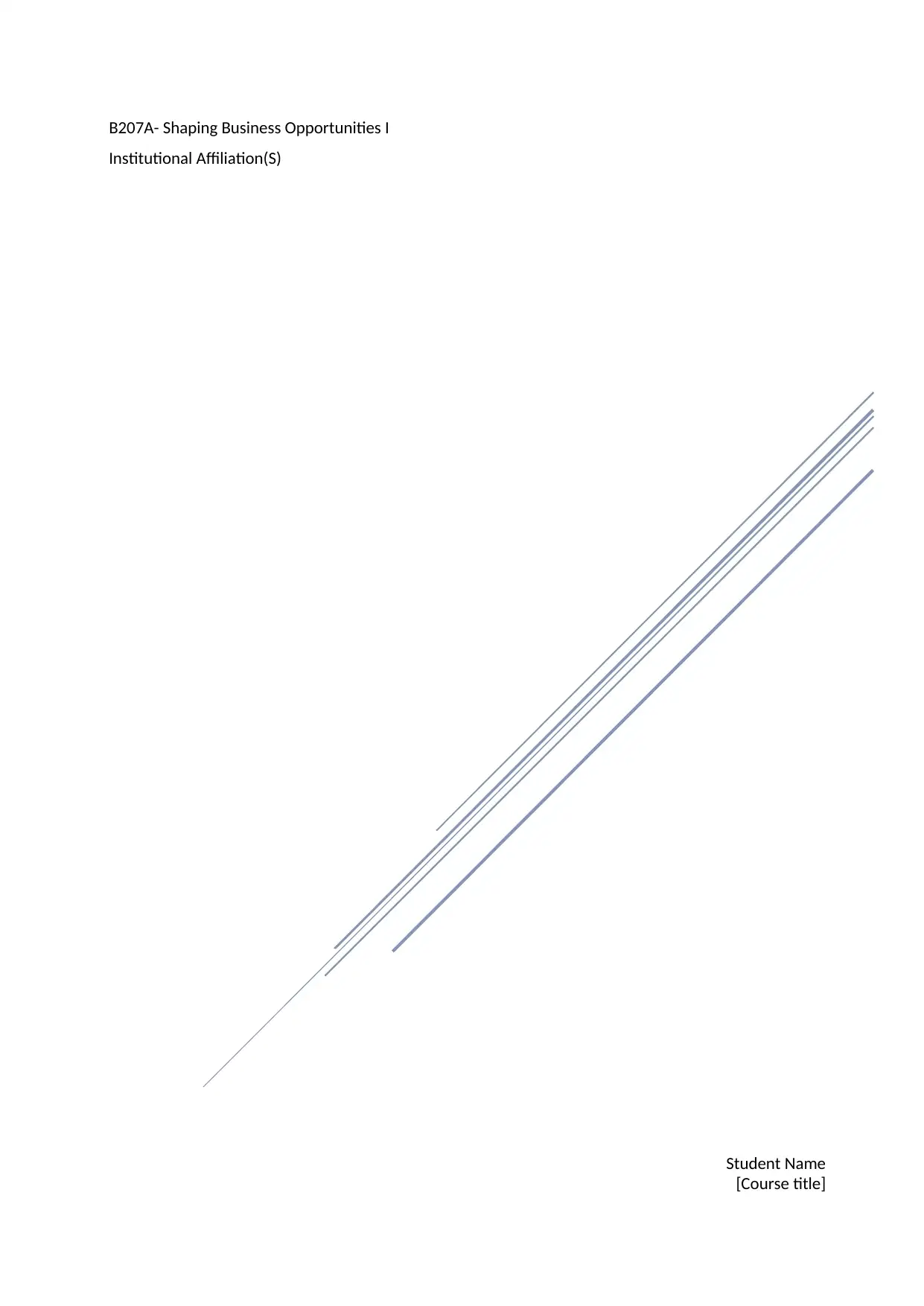
Student Name
[Course title]
B207A- Shaping Business Opportunities I
Institutional Affiliation(S)
[Course title]
B207A- Shaping Business Opportunities I
Institutional Affiliation(S)
Secure Best Marks with AI Grader
Need help grading? Try our AI Grader for instant feedback on your assignments.
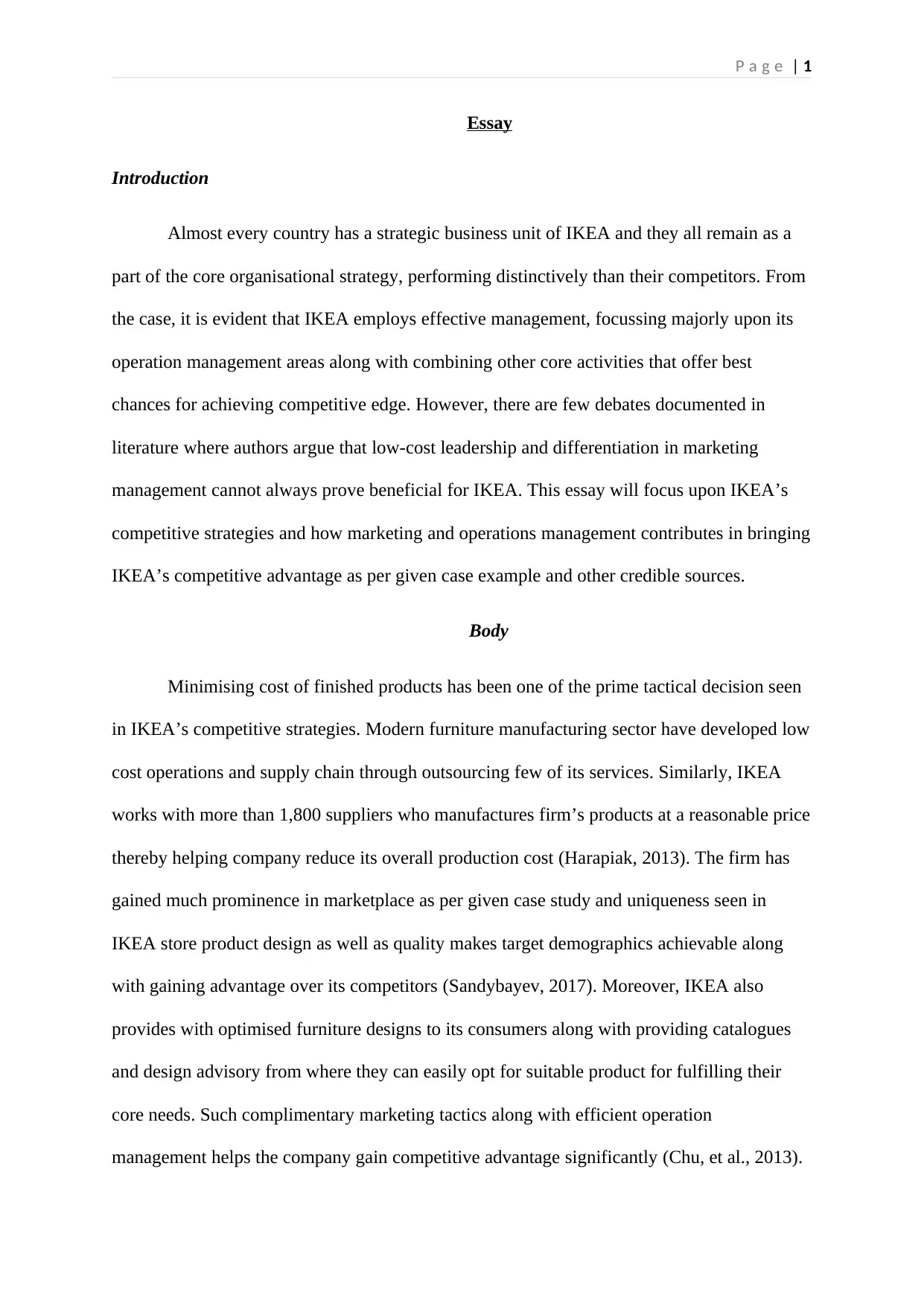
P a g e | 1
Essay
Introduction
Almost every country has a strategic business unit of IKEA and they all remain as a
part of the core organisational strategy, performing distinctively than their competitors. From
the case, it is evident that IKEA employs effective management, focussing majorly upon its
operation management areas along with combining other core activities that offer best
chances for achieving competitive edge. However, there are few debates documented in
literature where authors argue that low-cost leadership and differentiation in marketing
management cannot always prove beneficial for IKEA. This essay will focus upon IKEA’s
competitive strategies and how marketing and operations management contributes in bringing
IKEA’s competitive advantage as per given case example and other credible sources.
Body
Minimising cost of finished products has been one of the prime tactical decision seen
in IKEA’s competitive strategies. Modern furniture manufacturing sector have developed low
cost operations and supply chain through outsourcing few of its services. Similarly, IKEA
works with more than 1,800 suppliers who manufactures firm’s products at a reasonable price
thereby helping company reduce its overall production cost (Harapiak, 2013). The firm has
gained much prominence in marketplace as per given case study and uniqueness seen in
IKEA store product design as well as quality makes target demographics achievable along
with gaining advantage over its competitors (Sandybayev, 2017). Moreover, IKEA also
provides with optimised furniture designs to its consumers along with providing catalogues
and design advisory from where they can easily opt for suitable product for fulfilling their
core needs. Such complimentary marketing tactics along with efficient operation
management helps the company gain competitive advantage significantly (Chu, et al., 2013).
Essay
Introduction
Almost every country has a strategic business unit of IKEA and they all remain as a
part of the core organisational strategy, performing distinctively than their competitors. From
the case, it is evident that IKEA employs effective management, focussing majorly upon its
operation management areas along with combining other core activities that offer best
chances for achieving competitive edge. However, there are few debates documented in
literature where authors argue that low-cost leadership and differentiation in marketing
management cannot always prove beneficial for IKEA. This essay will focus upon IKEA’s
competitive strategies and how marketing and operations management contributes in bringing
IKEA’s competitive advantage as per given case example and other credible sources.
Body
Minimising cost of finished products has been one of the prime tactical decision seen
in IKEA’s competitive strategies. Modern furniture manufacturing sector have developed low
cost operations and supply chain through outsourcing few of its services. Similarly, IKEA
works with more than 1,800 suppliers who manufactures firm’s products at a reasonable price
thereby helping company reduce its overall production cost (Harapiak, 2013). The firm has
gained much prominence in marketplace as per given case study and uniqueness seen in
IKEA store product design as well as quality makes target demographics achievable along
with gaining advantage over its competitors (Sandybayev, 2017). Moreover, IKEA also
provides with optimised furniture designs to its consumers along with providing catalogues
and design advisory from where they can easily opt for suitable product for fulfilling their
core needs. Such complimentary marketing tactics along with efficient operation
management helps the company gain competitive advantage significantly (Chu, et al., 2013).
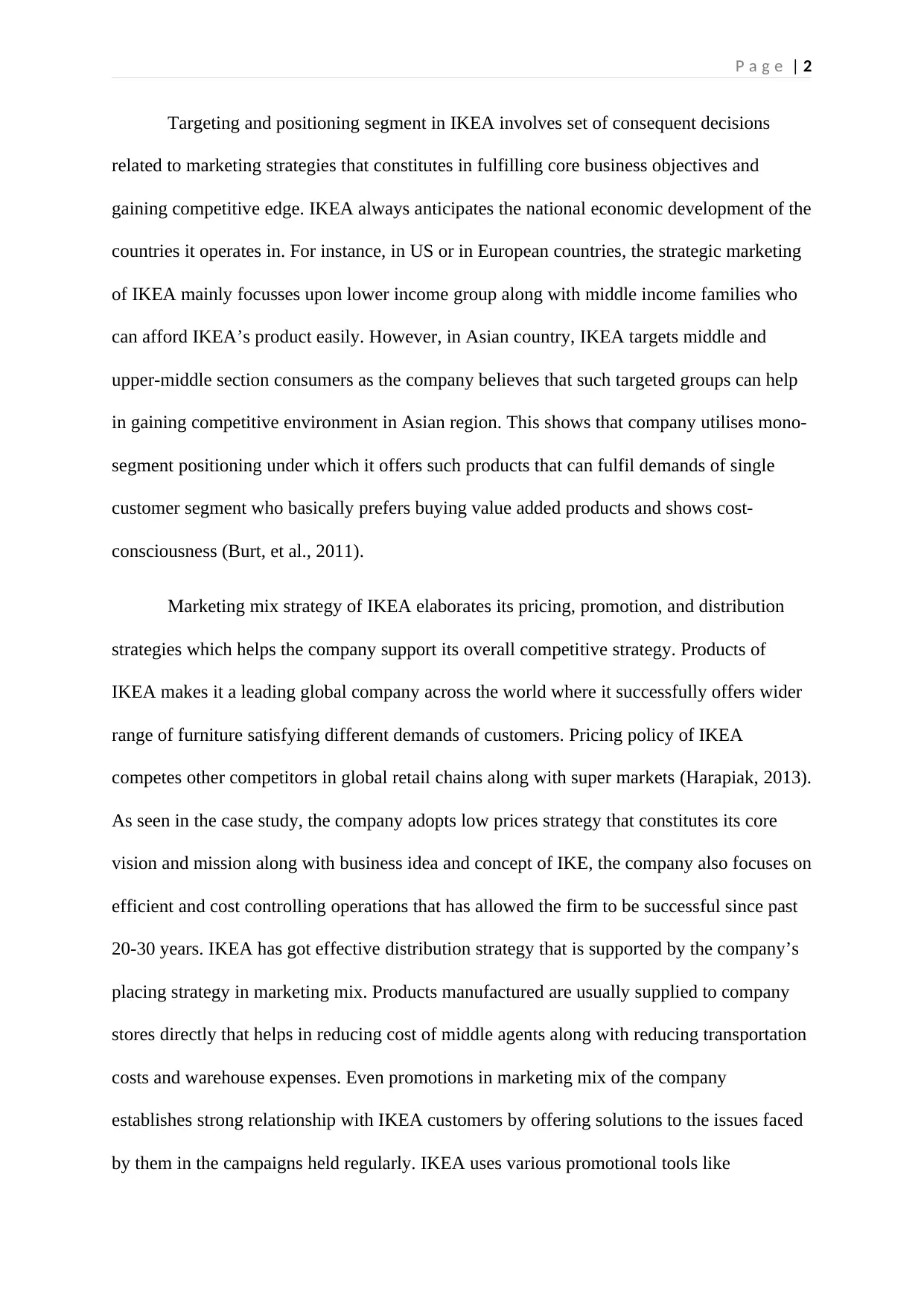
P a g e | 2
Targeting and positioning segment in IKEA involves set of consequent decisions
related to marketing strategies that constitutes in fulfilling core business objectives and
gaining competitive edge. IKEA always anticipates the national economic development of the
countries it operates in. For instance, in US or in European countries, the strategic marketing
of IKEA mainly focusses upon lower income group along with middle income families who
can afford IKEA’s product easily. However, in Asian country, IKEA targets middle and
upper-middle section consumers as the company believes that such targeted groups can help
in gaining competitive environment in Asian region. This shows that company utilises mono-
segment positioning under which it offers such products that can fulfil demands of single
customer segment who basically prefers buying value added products and shows cost-
consciousness (Burt, et al., 2011).
Marketing mix strategy of IKEA elaborates its pricing, promotion, and distribution
strategies which helps the company support its overall competitive strategy. Products of
IKEA makes it a leading global company across the world where it successfully offers wider
range of furniture satisfying different demands of customers. Pricing policy of IKEA
competes other competitors in global retail chains along with super markets (Harapiak, 2013).
As seen in the case study, the company adopts low prices strategy that constitutes its core
vision and mission along with business idea and concept of IKE, the company also focuses on
efficient and cost controlling operations that has allowed the firm to be successful since past
20-30 years. IKEA has got effective distribution strategy that is supported by the company’s
placing strategy in marketing mix. Products manufactured are usually supplied to company
stores directly that helps in reducing cost of middle agents along with reducing transportation
costs and warehouse expenses. Even promotions in marketing mix of the company
establishes strong relationship with IKEA customers by offering solutions to the issues faced
by them in the campaigns held regularly. IKEA uses various promotional tools like
Targeting and positioning segment in IKEA involves set of consequent decisions
related to marketing strategies that constitutes in fulfilling core business objectives and
gaining competitive edge. IKEA always anticipates the national economic development of the
countries it operates in. For instance, in US or in European countries, the strategic marketing
of IKEA mainly focusses upon lower income group along with middle income families who
can afford IKEA’s product easily. However, in Asian country, IKEA targets middle and
upper-middle section consumers as the company believes that such targeted groups can help
in gaining competitive environment in Asian region. This shows that company utilises mono-
segment positioning under which it offers such products that can fulfil demands of single
customer segment who basically prefers buying value added products and shows cost-
consciousness (Burt, et al., 2011).
Marketing mix strategy of IKEA elaborates its pricing, promotion, and distribution
strategies which helps the company support its overall competitive strategy. Products of
IKEA makes it a leading global company across the world where it successfully offers wider
range of furniture satisfying different demands of customers. Pricing policy of IKEA
competes other competitors in global retail chains along with super markets (Harapiak, 2013).
As seen in the case study, the company adopts low prices strategy that constitutes its core
vision and mission along with business idea and concept of IKE, the company also focuses on
efficient and cost controlling operations that has allowed the firm to be successful since past
20-30 years. IKEA has got effective distribution strategy that is supported by the company’s
placing strategy in marketing mix. Products manufactured are usually supplied to company
stores directly that helps in reducing cost of middle agents along with reducing transportation
costs and warehouse expenses. Even promotions in marketing mix of the company
establishes strong relationship with IKEA customers by offering solutions to the issues faced
by them in the campaigns held regularly. IKEA uses various promotional tools like
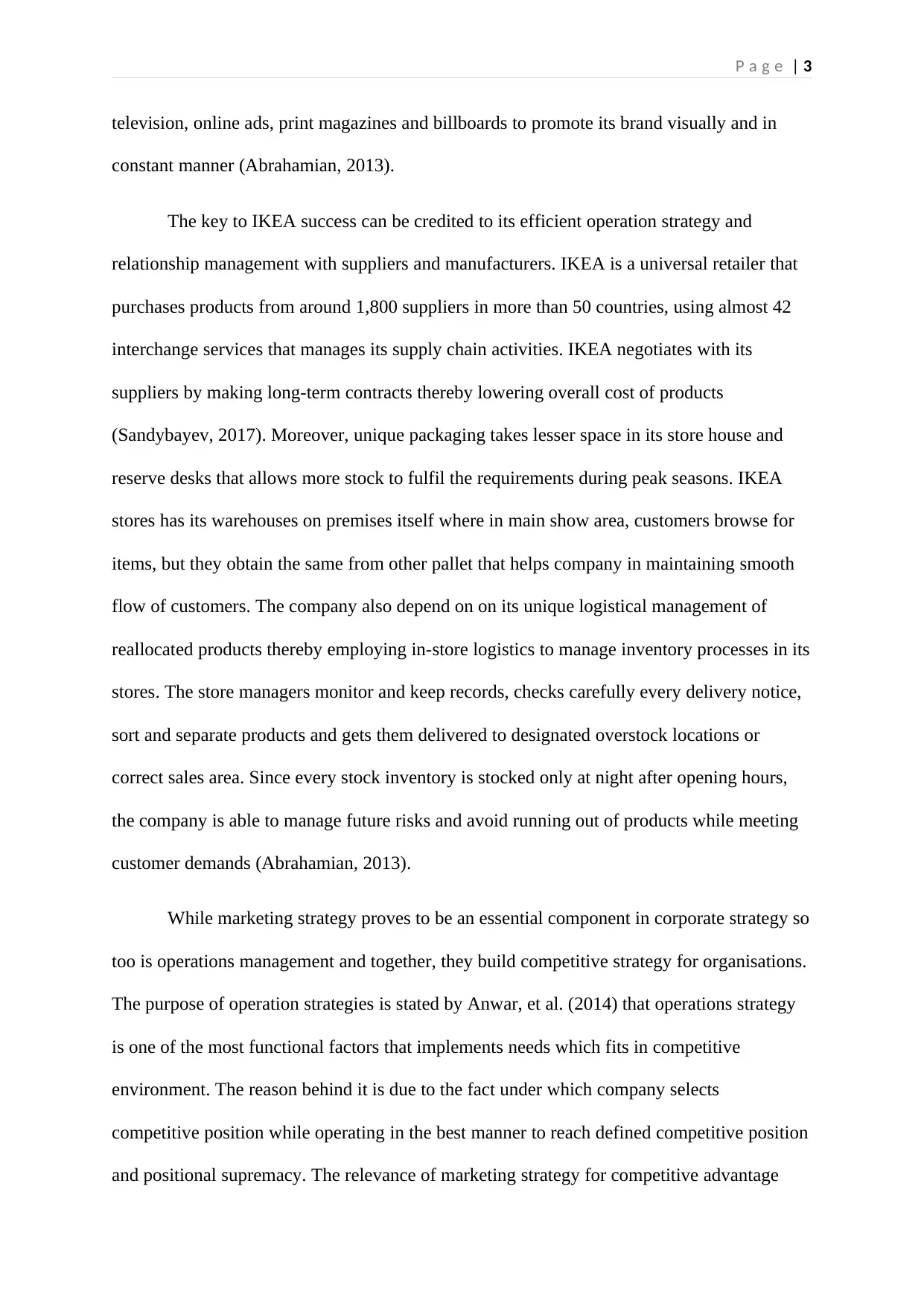
P a g e | 3
television, online ads, print magazines and billboards to promote its brand visually and in
constant manner (Abrahamian, 2013).
The key to IKEA success can be credited to its efficient operation strategy and
relationship management with suppliers and manufacturers. IKEA is a universal retailer that
purchases products from around 1,800 suppliers in more than 50 countries, using almost 42
interchange services that manages its supply chain activities. IKEA negotiates with its
suppliers by making long-term contracts thereby lowering overall cost of products
(Sandybayev, 2017). Moreover, unique packaging takes lesser space in its store house and
reserve desks that allows more stock to fulfil the requirements during peak seasons. IKEA
stores has its warehouses on premises itself where in main show area, customers browse for
items, but they obtain the same from other pallet that helps company in maintaining smooth
flow of customers. The company also depend on on its unique logistical management of
reallocated products thereby employing in-store logistics to manage inventory processes in its
stores. The store managers monitor and keep records, checks carefully every delivery notice,
sort and separate products and gets them delivered to designated overstock locations or
correct sales area. Since every stock inventory is stocked only at night after opening hours,
the company is able to manage future risks and avoid running out of products while meeting
customer demands (Abrahamian, 2013).
While marketing strategy proves to be an essential component in corporate strategy so
too is operations management and together, they build competitive strategy for organisations.
The purpose of operation strategies is stated by Anwar, et al. (2014) that operations strategy
is one of the most functional factors that implements needs which fits in competitive
environment. The reason behind it is due to the fact under which company selects
competitive position while operating in the best manner to reach defined competitive position
and positional supremacy. The relevance of marketing strategy for competitive advantage
television, online ads, print magazines and billboards to promote its brand visually and in
constant manner (Abrahamian, 2013).
The key to IKEA success can be credited to its efficient operation strategy and
relationship management with suppliers and manufacturers. IKEA is a universal retailer that
purchases products from around 1,800 suppliers in more than 50 countries, using almost 42
interchange services that manages its supply chain activities. IKEA negotiates with its
suppliers by making long-term contracts thereby lowering overall cost of products
(Sandybayev, 2017). Moreover, unique packaging takes lesser space in its store house and
reserve desks that allows more stock to fulfil the requirements during peak seasons. IKEA
stores has its warehouses on premises itself where in main show area, customers browse for
items, but they obtain the same from other pallet that helps company in maintaining smooth
flow of customers. The company also depend on on its unique logistical management of
reallocated products thereby employing in-store logistics to manage inventory processes in its
stores. The store managers monitor and keep records, checks carefully every delivery notice,
sort and separate products and gets them delivered to designated overstock locations or
correct sales area. Since every stock inventory is stocked only at night after opening hours,
the company is able to manage future risks and avoid running out of products while meeting
customer demands (Abrahamian, 2013).
While marketing strategy proves to be an essential component in corporate strategy so
too is operations management and together, they build competitive strategy for organisations.
The purpose of operation strategies is stated by Anwar, et al. (2014) that operations strategy
is one of the most functional factors that implements needs which fits in competitive
environment. The reason behind it is due to the fact under which company selects
competitive position while operating in the best manner to reach defined competitive position
and positional supremacy. The relevance of marketing strategy for competitive advantage
Secure Best Marks with AI Grader
Need help grading? Try our AI Grader for instant feedback on your assignments.
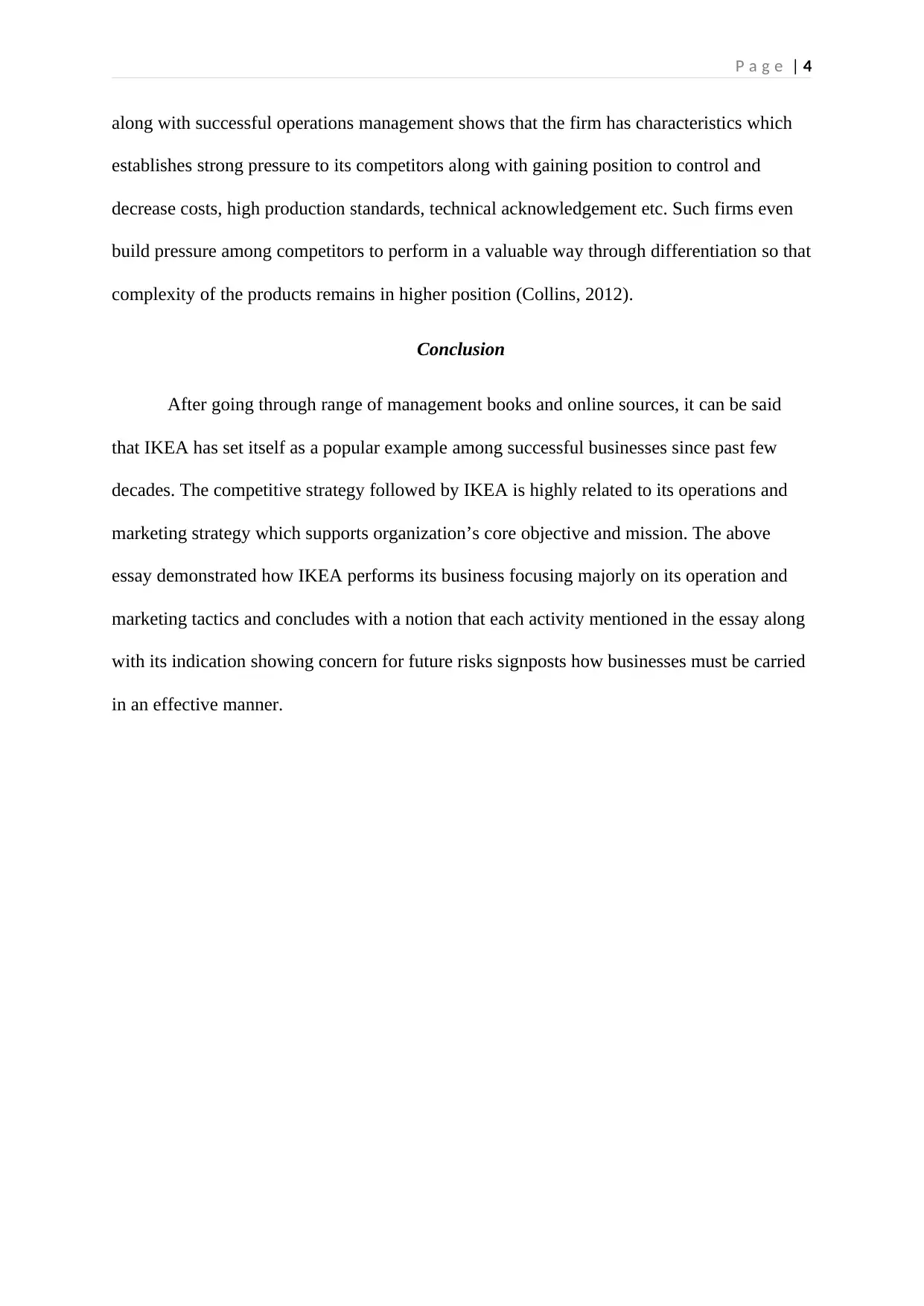
P a g e | 4
along with successful operations management shows that the firm has characteristics which
establishes strong pressure to its competitors along with gaining position to control and
decrease costs, high production standards, technical acknowledgement etc. Such firms even
build pressure among competitors to perform in a valuable way through differentiation so that
complexity of the products remains in higher position (Collins, 2012).
Conclusion
After going through range of management books and online sources, it can be said
that IKEA has set itself as a popular example among successful businesses since past few
decades. The competitive strategy followed by IKEA is highly related to its operations and
marketing strategy which supports organization’s core objective and mission. The above
essay demonstrated how IKEA performs its business focusing majorly on its operation and
marketing tactics and concludes with a notion that each activity mentioned in the essay along
with its indication showing concern for future risks signposts how businesses must be carried
in an effective manner.
along with successful operations management shows that the firm has characteristics which
establishes strong pressure to its competitors along with gaining position to control and
decrease costs, high production standards, technical acknowledgement etc. Such firms even
build pressure among competitors to perform in a valuable way through differentiation so that
complexity of the products remains in higher position (Collins, 2012).
Conclusion
After going through range of management books and online sources, it can be said
that IKEA has set itself as a popular example among successful businesses since past few
decades. The competitive strategy followed by IKEA is highly related to its operations and
marketing strategy which supports organization’s core objective and mission. The above
essay demonstrated how IKEA performs its business focusing majorly on its operation and
marketing tactics and concludes with a notion that each activity mentioned in the essay along
with its indication showing concern for future risks signposts how businesses must be carried
in an effective manner.
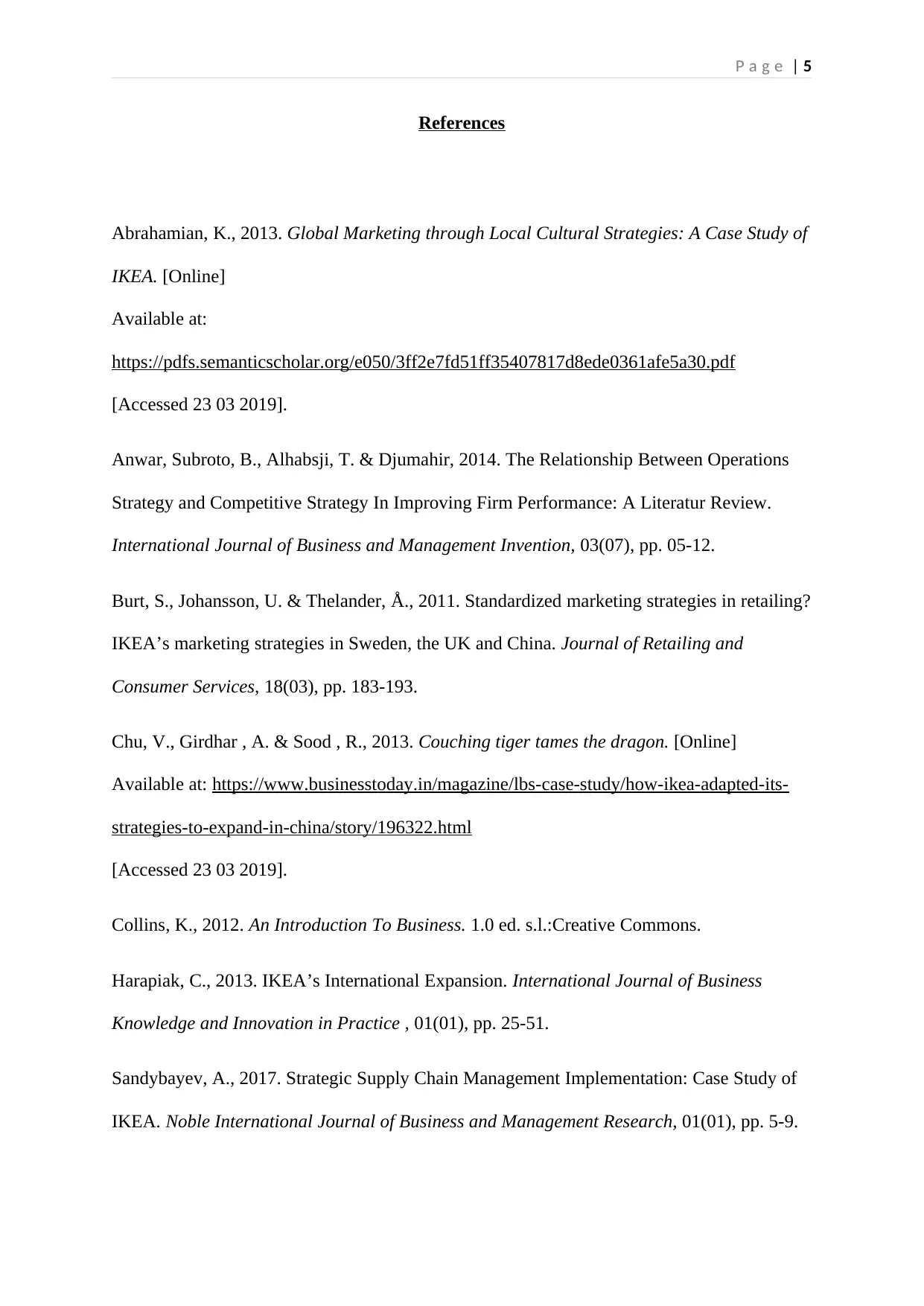
P a g e | 5
References
Abrahamian, K., 2013. Global Marketing through Local Cultural Strategies: A Case Study of
IKEA. [Online]
Available at:
https://pdfs.semanticscholar.org/e050/3ff2e7fd51ff35407817d8ede0361afe5a30.pdf
[Accessed 23 03 2019].
Anwar, Subroto, B., Alhabsji, T. & Djumahir, 2014. The Relationship Between Operations
Strategy and Competitive Strategy In Improving Firm Performance: A Literatur Review.
International Journal of Business and Management Invention, 03(07), pp. 05-12.
Burt, S., Johansson, U. & Thelander, Å., 2011. Standardized marketing strategies in retailing?
IKEA’s marketing strategies in Sweden, the UK and China. Journal of Retailing and
Consumer Services, 18(03), pp. 183-193.
Chu, V., Girdhar , A. & Sood , R., 2013. Couching tiger tames the dragon. [Online]
Available at: https://www.businesstoday.in/magazine/lbs-case-study/how-ikea-adapted-its-
strategies-to-expand-in-china/story/196322.html
[Accessed 23 03 2019].
Collins, K., 2012. An Introduction To Business. 1.0 ed. s.l.:Creative Commons.
Harapiak, C., 2013. IKEA’s International Expansion. International Journal of Business
Knowledge and Innovation in Practice , 01(01), pp. 25-51.
Sandybayev, A., 2017. Strategic Supply Chain Management Implementation: Case Study of
IKEA. Noble International Journal of Business and Management Research, 01(01), pp. 5-9.
References
Abrahamian, K., 2013. Global Marketing through Local Cultural Strategies: A Case Study of
IKEA. [Online]
Available at:
https://pdfs.semanticscholar.org/e050/3ff2e7fd51ff35407817d8ede0361afe5a30.pdf
[Accessed 23 03 2019].
Anwar, Subroto, B., Alhabsji, T. & Djumahir, 2014. The Relationship Between Operations
Strategy and Competitive Strategy In Improving Firm Performance: A Literatur Review.
International Journal of Business and Management Invention, 03(07), pp. 05-12.
Burt, S., Johansson, U. & Thelander, Å., 2011. Standardized marketing strategies in retailing?
IKEA’s marketing strategies in Sweden, the UK and China. Journal of Retailing and
Consumer Services, 18(03), pp. 183-193.
Chu, V., Girdhar , A. & Sood , R., 2013. Couching tiger tames the dragon. [Online]
Available at: https://www.businesstoday.in/magazine/lbs-case-study/how-ikea-adapted-its-
strategies-to-expand-in-china/story/196322.html
[Accessed 23 03 2019].
Collins, K., 2012. An Introduction To Business. 1.0 ed. s.l.:Creative Commons.
Harapiak, C., 2013. IKEA’s International Expansion. International Journal of Business
Knowledge and Innovation in Practice , 01(01), pp. 25-51.
Sandybayev, A., 2017. Strategic Supply Chain Management Implementation: Case Study of
IKEA. Noble International Journal of Business and Management Research, 01(01), pp. 5-9.
1 out of 6
Related Documents
Your All-in-One AI-Powered Toolkit for Academic Success.
+13062052269
info@desklib.com
Available 24*7 on WhatsApp / Email
![[object Object]](/_next/static/media/star-bottom.7253800d.svg)
Unlock your academic potential
© 2024 | Zucol Services PVT LTD | All rights reserved.





